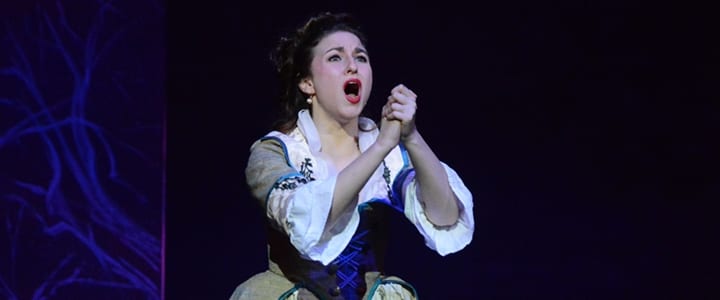Interested in opera singing? You may run into the word “coloratura” in your studies. Here, vocal instructor Molly R. will give you the inside scoop on what the term means, and what you need to know to get started with the technique…
Coloratura! A fancy word for a very fancy vocal device. Coloratura is ornamentation done in classical singing: think trills, big leaps, and intricate melismas (also known as vocal runs). The most intricate coloratura singing involves cadenzas, which are improvised vocal flourishes. There’s even a very special voice type, the coloratura soprano, who’s expected to be a vocal virtuoso who sings well above high “C” (C6)!
An Example of Coloratura Singing
Certain opera composers, such as Mozart and Rossini, are known for writing music that contains coloratura showpieces. Perhaps one of the best examples of powerhouse coloratura singing is one of the arias the Queen of the Night sings in Mozart’s “Magic Flute.”
These arias can be quite daunting to the novice singer! However, the key to mastering ANYTHING is starting small. There are plenty of vocal exercises and songs that will prepare you for more advanced repertoire later on in your studies.
How to Sing Coloratura
Singing requires many skills beyond controlling your breathing and hitting the right notes. Here are the first steps to take when learning how to master the art of coloratura singing.
1. Become REALLY well-acquainted with your lower support muscles.
In order to sing good, clean, and accurate coloratura, you must “sing where you laugh.”
The best vocal warm-up for this is a simple staccato exercise, which will strengthen your core and increase overall flexibility throughout your vocal range. Here’s an example of an exercise to try:
2. Practice intervals and pitch accuracy.
Accuracy is key so that your notes are dead-on and not sloppy or out of tune. A really fun “go-to” in my studio is Kim Chandler’s series called “Funky ‘n Fun.” Although geared for non-classical singers, her exercises that focus on intervals are tremendously helpful for the ear AND the voice!
3. Get some “old school” books written by vocal masters.
There’s a wealth of information on coloratura singing written by experts who are well-versed in the practice. Having resources to reference to will aid in your practice and understanding of valuable singing techniques. Here are a few of my top picks:
- Mathilde Marchesi’s “Bel Canto” – This book’s exercises start small, with simple two-note “shakes” and three-note “trills”, building you up for more elaborate ornamentation as the book progresses. These exercises can easily be played on the piano by a novice!
- Estelle Liebling’s “Vocal Course for Coloratuna Soprano” – Estelle Liebling is a student of Marchesi and teacher of one of the finest coloratura sopranos, Beverly Sills. These exercises start simply and build in complexity. Liebling, like Marchesi, stresses clean, pure-tone, and rock-solid lower support. These are indeed the two main things a singer must master to sing coloratura!
- Estelle Liebling’s “Coloratura Cadenzas” – This book is for later in the coloratura soprano’s studies. It provides various options for cadenzas a soprano may insert into many famous arias. Do note that these arias are not to be studied until a student has mastered the basics — but it may be a good idea to have this book on hand to see what musicality is necessary for singing a cadenza.
What Are Some Songs for the Coloratura Soprano?
At this point, you may wonder what some popular but simple coloratura songs sound like. Below are a couple suggestions for repertoire that may be helpful for beginner coloraturas before they build up to coloratura opera arias.
“Poor Wandering One” from “Pirates of Penzance” by Gilbert and Sullivan
This is the place to start! It’s short, in English, and has a section that will definitely get a soprano on the right track for singing good, clean high notes.
“I Know That My Redeemer Liveth” from Handel’s “Messiah”
Handel oratorio arias are excellent preparation for florid singing. It’s also wise for a soprano singer to learn “Messiah”, anyway — it’s a staple among classical music repertoire and chances are you may be asked to sing it at some point in your career. Many of Handel’s operatic arias are must faster, but the slower tempo of this piece allows your voice to really get the hang of the trill.
Final Thoughts
Coloratura singing is NOT one of those skills you can learn on your own. It’s very important that you have the eyes and ears of a trusted voice teacher guide you through it, and most importantly, assess when you’re ready to tackle more advanced repertoire.
There are many fantastic vocal instructors on TakeLessons.com. If you don’t have a teacher already, browse around to find your ideal instructor and get started now!
 Post Author: Molly R.
Post Author: Molly R.Molly R. teaches online and in-person singing lessons in Hayward, CA. Her specialties include teaching beginner vocalists, shy singers, children, teens, lapsed singers, and older beginners. She joined TakeLessons in November 2013. Learn more about Molly here!
Photo by Baldwin Wallace University
Suzy S.


